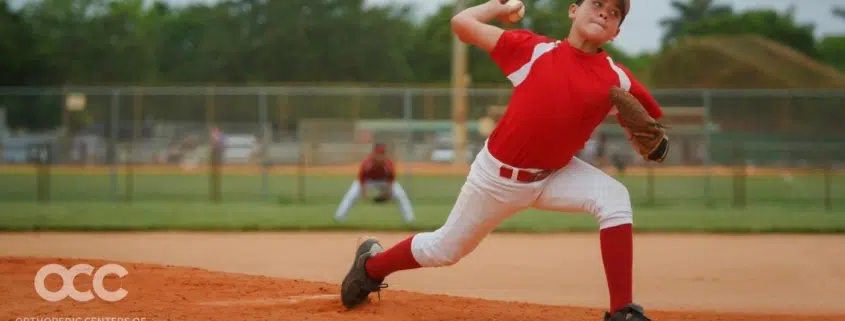UCL Reconstruction (aka Tommy John Surgery): Effective Treatment for Overuse Elbow Injuries
Ulnar Collateral Ligament Reconstruction, more commonly known as Tommy John surgery, is the treatment for an overuse injury that strains the ligament on the inside of the elbow and leads to an ulnar collateral ligament (UCL) tear.
Summer sports are in full swing! As athletes take to the court, trail, or field, intense, repetitive activity surge can lead to muscle and joint stress, strain, or injury. It’s natural for athletes of all levels to push themselves to compete and grow, but when muscles are pushed beyond their limits or not given time to recover, injuries happen.
Overuse injuries can have serious consequences, so injury prevention is your best defense. That begins with a balanced approach that prioritizes pre-season conditioning to lessen the impact of a seasonal activity spike, training moderation during the season that allows muscle recovery, and off-season training variation that balances out muscle workload.
Regardless of best-laid plans, muscle stress does occur, but by recognizing and acting on warning signs, you can prevent greater injury. If you experience persistent muscle or joint pain, numbness, or weakness performing a core movement such as throwing, stop your high-intensity activity and seek medical evaluation.
Baseball and softball are common sports for overuse injuries. The high frequency of throwing, combined with the high intensity and high volume of games, is a recipe for injury.
Although the pitching motion in softball creates different arm strain than in baseball, overuse can still lead to rotator cuff injuries or inflammation of a tendon (tendonitis) in the elbow or shoulder. If the inflammation presents in the muscles or tendons within the forearm, lateral epicondylitis – or tennis elbow – may result. Lateral epicondylitis causes severe pain or sensitivity on the outside of the elbow. Despite its association with the sport of tennis, its occurrence in softball is common. Overuse can also irritate or compress the ulnar nerve in the arm, causing cubital tunnel syndrome or ulnar neuritis. This nerve condition is marked by numbness or tingling in the fingers or a weakened grip.
The intensity of the throwing motion in baseball tends to take the greatest toll on the elbow. It’s not surprising that a major corrective procedure for throwing overuse bears an informal name taken from the first major league baseball player to successfully undergo treatment and return to active competition – Tommy John.
Ulnar Collateral Ligament Reconstruction, more commonly known as Tommy John surgery, is the treatment for an overuse injury that strains the ligament on the inside of the elbow and leads to an ulnar collateral ligament (UCL) tear. UCL ruptures are not confined to baseball. Despite the origins of its informal name, UCL tears are frequently found in tennis, gymnastics, football, and cheerleading.
The UCL connects the humerus to the ulna on the inside of the elbow and provides stability. When the UCL is torn during the repetition of high-velocity motions – such as throwing a baseball – corrective action may be needed to restore joint function and range of motion.
Symptoms of a damaged UCL include swelling, pain on the inside of the elbow while throwing, loss of ability to throw, and persistent elbow pain while not throwing. Symptoms such as tingling in the pinkie or ring finger may be an indicator of ulnar nerve irritation.
During a medical evaluation, your physician will complete a thorough examination that includes physical tests as well as joint imagery (MRI, X-rays) to determine the nature and severity of the damage.
Some UCL injuries can be addressed with conservative treatments, including rest from high-intensity activity, anti-inflammatory medicine, and strength exercises. Complete tears may require surgical correction.
UCL reconstruction is the replacement of the UCL with a graft from the foot, forearm, or hamstring. A donor graft may also be used. During this 60-90 minute outpatient procedure, an incision on the inside of the elbow provides access for the orthopedic surgeon to move the healthy muscle and tissue out of the way and access the UCL. The damaged portion of the torn ligament is removed, and the area for the new graft is prepared. Holes are drilled into the humerus and ulna to connect the new graft. In some instances, a portion of the original ligament is attached to the new graft as an additional fortification.
Depending on the individual circumstances of the procedure, the new graft may be attached with a variety of traditional or minimally invasive anchoring techniques.
Recovery begins by protecting the new graft and maintaining the surrounding muscle strength. The joint is initially immobilized to limit inflammation and aid healing, while therapy targets the surrounding shoulder and bicep muscles to mitigate atrophy during the joint healing process.
A rehabilitation plan will progressively increase the range of motion. Full elbow extension is generally realized within 30 days, and elbow strengthening exercises can begin after six weeks. A full range of motion is often achieved in two-four months. Soft toss motions can begin after four months, with additional steps advancing case by case.
Each step is closely monitored by your surgeon and recovery team prior to increasing activity. Competitive athletes may follow a more gradual recovery that incorporates dedicated sport-specific strength training to support the strain from future use. It is not uncommon for elite-level athletes to require nine months or longer to achieve full clearance for competition. A successful rehabilitation program is essential to a positive outcome.
UCL reconstruction surgery has a high success rate, and many successfully restore normal activity. Contact the upper extremity team at the Colorado Center of Orthopaedic Excellence to learn more about UCL reconstruction surgery.


